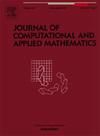反应扩散方程各向异性变时步长fem的最优误差估计及超收敛分析
IF 2.1
2区 数学
Q1 MATHEMATICS, APPLIED
Journal of Computational and Applied Mathematics
Pub Date : 2025-03-31
DOI:10.1016/j.cam.2025.116656
引用次数: 0
摘要
将变时间步长两步后向微分公式(VSBDF2)与各向异性有限元法(fem)相结合,构造了反应扩散方程在时间和空间上均不均匀网格的完全离散格式。在温和的相邻时间步长比限制0<;rk<rmax≈4.8645下,给出了两种方法来证明l2 -范数的最优误差估计和h1 -范数的全局超收敛结果。第一种方法是利用插值算子的各向异性特性,但对解的正则性要求较高,且只对某些特殊元素有效。第二种方法基于插值算子和能量投影算子的结合技术,对解的正则性要求较低,可视为收敛分析的统一框架。数值实验证明了我们的理论分析。本文章由计算机程序翻译,如有差异,请以英文原文为准。
Optimal error estimations and superconvergence analysis of anisotropic FEMs with variable time steps for reaction–diffusion equations
By combining variable-time-step two-step backward differentiation formula (VSBDF2) with anisotropic finite element methods (FEMs), a fully discrete scheme with non-uniform meshes both in time and space is constructed for the reaction–diffusion equations. Two approaches are provided to prove the optimal error estimates in -norm and global superconvergence result in -norm under a mild adjacent time-step ratio restriction . The first approach is based on the use of anisotropic properties of the interpolation operators, but needs a higher regularity of the solution and is only valid for some special elements. The second approach is based on the combination technique of interpolation and energy projection operators, and needs a lower regularity of the solution, which can be regarded as a unified framework of convergence analysis. Numerical experiments are provided to demonstrate our theoretical analysis.
求助全文
通过发布文献求助,成功后即可免费获取论文全文。
去求助
来源期刊
CiteScore
5.40
自引率
4.20%
发文量
437
审稿时长
3.0 months
期刊介绍:
The Journal of Computational and Applied Mathematics publishes original papers of high scientific value in all areas of computational and applied mathematics. The main interest of the Journal is in papers that describe and analyze new computational techniques for solving scientific or engineering problems. Also the improved analysis, including the effectiveness and applicability, of existing methods and algorithms is of importance. The computational efficiency (e.g. the convergence, stability, accuracy, ...) should be proved and illustrated by nontrivial numerical examples. Papers describing only variants of existing methods, without adding significant new computational properties are not of interest.
The audience consists of: applied mathematicians, numerical analysts, computational scientists and engineers.

 求助内容:
求助内容: 应助结果提醒方式:
应助结果提醒方式:


